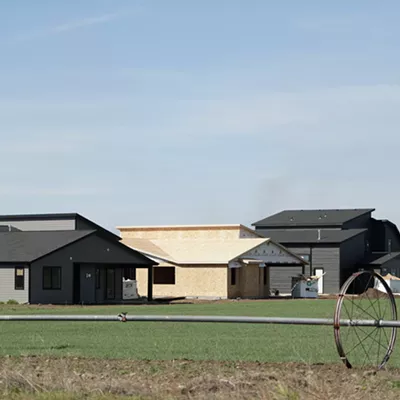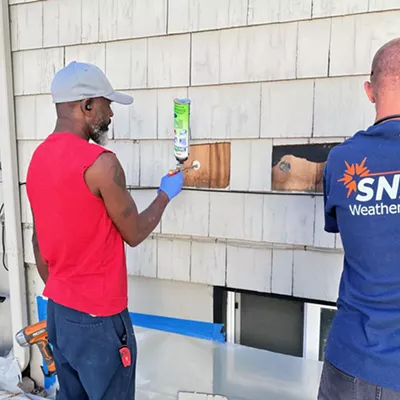We can't control the weather. But when we're hit with a cold snap like the one being experienced this week, the weather can lead us to think about more pressing issues, the ones we do control. For example, are Spokane County's more than 6,000 homeless people finding adequate shelter? Why did it take three days for the snow plows to get to most neighborhoods? And if everyone says global warming is burning up the planet, why are we shivering in subzero temperatures?
Heatless -- There are approximately 6,000 homeless people in Spokane County, though, of course, it's a transient population. When subzero temperatures arrive, the struggle to stay warm can become a struggle to survive.
"We've been seeing an increase of kids during the day for lunch and dinner," says Lonnie Keesee, director of Crosswalk, a downtown shelter for teenagers. "There have been close to 100 kids coming [during the day], but we have 16 beds and only about eight of them are filled."
Ed McCarron, director of the House of Charity, a shelter for homeless adults, says he's seeing the same thing: "We're packed to the gills here during the day, but we have not been that full [at night], and we only sleep men. We slept more people last year."
McCarron says an increase in transitional housing may be one reason the number of shelter seekers is down; another is the fact that many of the homeless have left for warmer weather.
Keesee says it's not just the homeless who need shelter: "There are a lot more kids who have homes, but not electricity or heat."
"We offer a number of programs to help," says Catherine Markson, communications manager at Avista, "like Project Share, which is on your bill. It's a program for people in emergency situations. The key is for people to call 1-800-227-9187 as soon as someone thinks they're going to have a problem or need assistance."
Extreme Weather -- Scientists working to educate the world about the effects of our diminishing ozone layer say the overall increase of extreme weather conditions around the globe -- whether freezing temperatures or blasting heat -- can be indications of global warming.
"The number of extreme events has been increasing," says George Mount, faculty member in the Laboratory of Atmospheric Research at WSU. "But, of course, so has the reporting of extreme weather."
Mount explains that while people may blame global warming for a variety of extreme weather conditions, it's far too complicated a process to understand what's causing our weather.
"In talking about the effects of global warming, yes, local weather will change," Mount says. "But it's very difficult to predict it on a local basis. Most would say the extreme events will continue to occur, but will shift around the earth. Some areas that are now experiencing radical changes will later have less."
Basically, an especially frigid winter in the Pacific Northwest isn't necessarily an indicator of global warming.
"There is a difference between weather and climate," Mount explains. "Climate is weather averaged over a period of time. Expect extremes in the weather." Only after weather has been averaged spatially and temporally and extremes have been detected is there a possible indication of global warming.
"Statistically, the U.S. extremes [in weather] have been less than the global extremes," Mount says. "I think things have gotten milder."
Plowing Spokane -- When you've dug out your driveway only to find multiple feet of snow on the streets, it's easy to curse an absent snowplow. Why aren't our neighborhood streets plowed right after a storm?
"Last Saturday, we had all 24 snow plows out around the clock," explains Scott Egger, director of Spokane's Street Department. "We still had calls from people asking, 'Are you plowing?' We can't be everywhere at once. We're giving it our best effort."
Egger says major arterials are always first up, including streets with hills, curves or those leading to emergency facilities. Residential hills are plowed next, and neighborhoods are the third priority.
"If we get a snow storm that requires us to plow out the city, we can get the arterials done in 24 hours," Egger estimates, "and then it takes about three more days to get all the residential streets. So with one storm, that's four to five days to complete the city."
Egger says they rotate which neighborhoods are plowed first. When more snow comes, the plows have to double back, reclearing main arterials. Right now the plows are working seven days a week, 24 hours a day. Still, Egger admits that the city's plowing equipment is "slower and less efficient" than it used to be, due to budget cuts in previous years.
"Over the past two or three years, [the plow budget] has remained at $1.7 million a year. I've been told [Spokane's] snow removal budget is lower than average," Egger says. Despite saving money some years, like the no-snow winter of 2002, surpluses go into the main Street Department budget.
Even though the snowplow budget could use a boost, Egger says what the city's 24 plows can pull off after a storm is remarkable. "We plow over 800 lane-miles of arterials within 24 hours, which is very efficient."
Publication date: 1/08/04
















